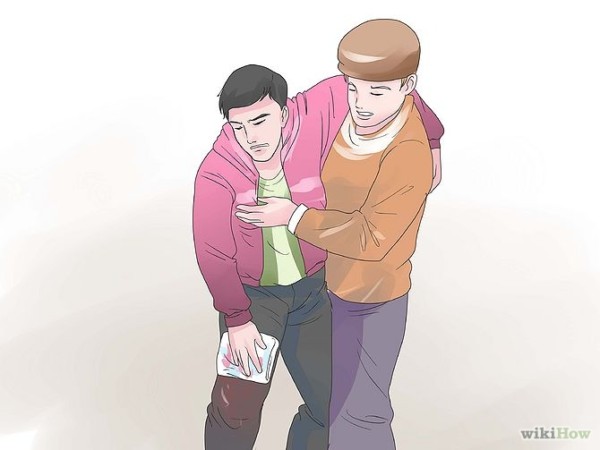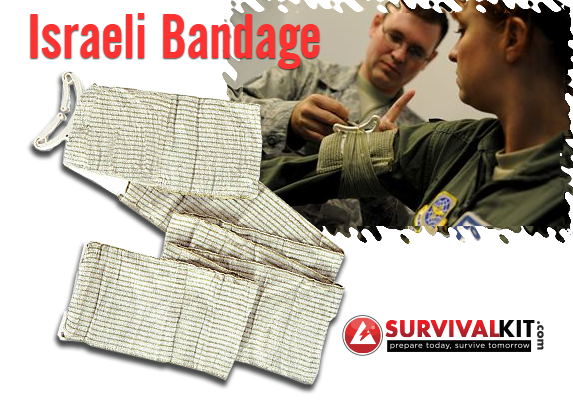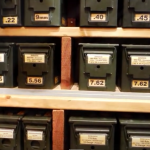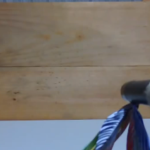Gunshot wounds are one of the most traumatic injuries you can suffer. It’s difficult to assess the extent of damage done by a gunshot wound, and most of them far exceed what you can reasonably treat with first aid. For this reason, the best option for most bullet wounds is to get the victim to a hospital as
soon as possible. However, this article will provide some guidance on what you can do to stabilize the victim in the meantime.

Make sure you are in a safe position.
- If the victim was shot unintentionally (e.g., while hunting), make sure that everyone’s firearm is pointed away from any other person(s), cleared of ammo, safe and secured.
- If the victim was shot in a crime, try to make sure that the shooter is no longer on the scene and that both you and the victim are safe from further injury. Wear personal protective equipment if available.
-
 2
2Call for help. Call for emergency medical assistance.
-
 3
3Tell the person that they’re okay and that you’re helping. Reassurance is important.
- Ask the person to talk to you.
- Ask the person to move his or her legs. This will help you gauge quickly how mobile the victim is.
- Keep the person warm.
-
 4
4Do not move the victim unless you must do so to keep him safe or to access care [1].
-
 5
5Act quickly. Time is your enemy in treating the victim. Victims who reach medical facilities during the “Golden Hour” have a much better likelihood of surviving. Try to keep your movements swift without making them frenzied.
-
 6
6Check the A, B, C, D, E’s. Assess these five critical factors [1]:
- A (Airway). If the person is talking, their airway is probably clear. If the person is unconscious, check to make sure that his airway is not obstructed. Turn the victim’s head to the side to facilitate better breathing and get the tongue out of the way. If the victim’s mouth is filled with blood, try to help them remove it by coughing or quickly sop it up with a rag or piece of clothing.
- B (Breathing). Is the victim taking regular breaths? Can you see his or her chest rising and falling? If the victim is not breathing, sweep his or her mouth for obstructions and start rescue breathing immediately.
- C (Circulation). Apply pressure to any bleeding, then check the victim’s pulse at the wrist or throat. Does the victim have a discernible pulse? If not, begin CPR. Control any major bleeding.
- D (Disability/Deformity). Disability refers to damage to the spinal cord or neck. Check to see if the victim can move hands and feet. If not, there may be an injury to the spinal cord. Deformity refers to things such as compound or obvious fractures, dislocations, or anything that looks out of place or unnatural. These injuries can be worsened by moving the victim.
- E (Exposure). Always look for an exit wound. Check the victim as thoroughly as possible for other wounds that you may be unaware of. Pay special attention to the armpit, buttocks or other difficult-to-see areas. Avoid completely undressing the victim before emergency help arrives as this may advance shock.
-
 7
7Control bleeding. Controlling bleeding is most important thing you can do to save a gunshot victim’s life[1].
- Applying direct pressure is the best way to control most wounds. Use a pad over the wound and apply pressure directly to the wound. If you have nothing available, even your hand or fingers can be used to control bleeding. Add new bandages over the old; do not remove bandages when they become soaked.
- Use pressure points in the arm (between the elbow and armpit), groin (along the bikini line), or behind the knee to control bleeding in the arm, thigh, or lower leg, respectively.
- There is little that can be done with conventional methods if the wound involves the torso, but chemical hemostats (QuickClot, Celox, etc.) have been proven to be very effective on all major bleeds. Ensure that you follow the instructions on the package for application, though it is usually as simple as holding the wound open, pouring in the powder or inserting the powder packet/sponge/applicator, and applying strong pressure for five minutes.
-
 8
8Be prepared to treat the victim for shock. Gunshot wounds frequently lead to shock, a condition caused by trauma or loss of blood that leads to reduced blood flow throughout the body[1]. Expect that a gunshot victim will show signs of shock and treat it accordingly by making sure the victim’s body temperature is as normal as possible – cover him up if his skin feels cold, or remove clothing and fan him if he’s burning up. However, do not elevate the legs if the gunshot wound is to the torso, as this will increase bleeding and make it more difficult for the victim to breathe.
-
 9
9Stay with the person. Continue to reassure and keep the victim warm. Wait for the authorities. If the blood congeals around the bullet wound, do not remove blood mats on wound, as this is acting to stopper the blood and prevent any more from flowing out.
Method 2 of 3: Special Instructions for Regions of the Body
-
 1
1Learn how to treat a bullet wound to the head. Gunshot wounds to the head are frequently fatal. Keep the head elevated and get the victim to a trauma center as soon as possible.
-
 2
2Learn how to treat a bullet wound to the face and neck. These wounds typically bleed severely. Use direct pressure to control bleeding and keep the victim upright. Be careful not to obstruct breathing while controlling bleeding. With injuries to the neck, be careful that blood flow to the carotid arteries isn’t disrupted, as this can reduce blood flow to the brain.
-
 3
3Learn how to treat a bullet wound to the chest and back. Apply direct pressure to control bleeding; understand that it may be difficult to control chest bleeding because the ribs make it difficult to compress the structures that are bleeding. Gunshots to the chest can cause what is known as a “sucking chest wound.” These happen when air travels in and out of the wound with each breath. Treat these as follows:[1]
- Seal wound with hand or airtight material (e.g., plastic film).
- Apply an airtight bandage on three sides of the wound (see image below). Do not close the bandage on the fourth side. This will allow the chest to achieve its usual negative pressure state. Air will escape through the valve during inhalation.
-
 4
4Learn how to treat a bullet wound to the abdomen. Apply direct pressure to the injury site. As with the chest, controlling bleeding in these cases can be quite difficult.
-
 5
5Learn how to treat a bullet wound to the arm or leg. Use direct pressure to control bleeding. If you have a length of fabric or string on hand (or can tear one off clothing), make a tourniquet. Arm and leg injuries from gunshots can be elevated above the heart to help control bleeding. Use pressure points in the arm, groin, or behind the knee if direct pressure does not control bleeding.
Method 3 of 3: For a Sucking Chest Wound
-
 1
1Seal the wound completely, on all four sides. Leaving the fourth side uncovered still will allow air to enter the chest cavity during inhalation, causing the lung to remain collapsed.
-
 2
2Apply direct pressure to both sides of the wound. It is possible to do this with two pads over each wound, held very tightly in place by a wrapped bandage.
-
 3
3Be sure to carefully monitor the patient’s breathing. You can do this by talking to the conscious patient, or watching the chest rise and fall.
- If there is evidence of respiratory failure (stopping breathing), reduce pressure on the wound to allow the chest to rise and fall.
- Prepare to perform rescue breathing.
-
 4
4Do not release pressure or remove the seal you made when medical assistance arrives. They will either use your seal or replace it with a better one.
Tips
- When medical assistance arrives, be prepared to inform them what you have done so far.
- Gunshots cause three types of trauma: penetration (destruction of flesh by the projectile), cavitation (damage from the bullet’s shock wave in the body), and fragmentation (caused by pieces of the projectile or lead).[1]
- It is very difficult to accurately assess the severity of a gunshot wound based upon what is visible on the victim; internal damage may be severe even in circumstances where the entrance and exit wounds are small.
- Do not worry about having sterile dressings or dirty hands. An infection can be treated later. However, do take precautions to protect yourself from the victim’s blood or other liquids. Do yourself a favor and wear gloves if at all possible.
- Gunshot wounds are a common cause of spinal cord injury. If the victim appears to have a spinal cord injury, do not move him unless you absolutely must. If you must move the victim, be sure to keep the head, neck and back aligned.
- Pressure is key, it stops the flow and contains the blood to help create a blood clot.
Warning
- Even with the best first aid, gunshot wounds may be fatal.
- Avoid blood-borne illnesses. Make sure any open wounds you may have do not come in contact with the victim’s blood.
- Do not put your own life at risk when treating a gunshot victim.















